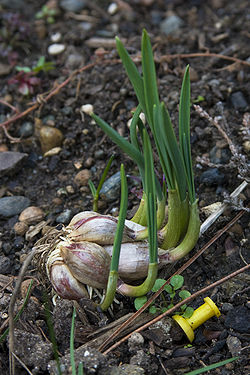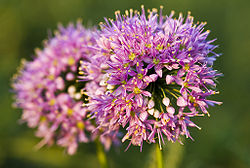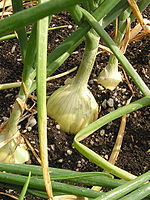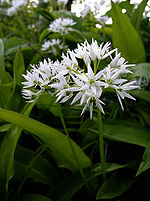Allium
| Allium |
|---|

|
| Scientific Classification |
|
| Selected Species |
|
| An example of the many types of flower heads that grow from an Allium. |
Allium is a taxonomic genus comprised of small the medium sized plants, with a thin stalk and long leaves with parallel venation. The roots of these plants are bulbs containing certain acids that give them a distinct odor. The bulbs of these plants are essential to vegetative reproduction. However, sexual reproduction is possible as well if the plant's flowers mature and pollinate. Alliums have also been used for culinary and medical purposes for thousands of years.
Anatomy
Alliums have many different flowers, colors, and sizes, but one thing all alliums have in common are their bulbous taproot. This root stores food for the plant, and is important in vegetative reproduction. An Allium is usually composed of a leafless stalk with flowers at the end. Most varieties, such as the leek have long parallel leaves growing up out of the bulb. Allium flowers are beautiful and have a range of many colors. Each separate flower is small, but can be part of a head up to 10cm in diameter [1]. Alliums are very different when you break them down into their species. Their stalk is anywhere from 5 to 150cm tall, and their bulb can be from 3mm thick, to 10cm thick [2].
Reproduction
Most Alliums are capable of vegetative and sexual reproduction. Their large tuber root either act as a rhizome and have other plants growing off of it, or they form buds and grows new bulbs around it depending on the variety. The other form of reproduction is sexual involving pollination of the flower.
Ecology
Alliums have a very large growing range. Because it is a genus, alliums are grown on every continent except Antarctica. Alliums are interesting in their wide variety of uses in the environment. Some alliums are used as house and garden plants to spruce up the yard [3], while others are considered weeds and are readily got rid of [4]. Some grow best wild; some have adapted to being cultivated and do not thrive well in the wild. Another thing that all alliums have in common is that most of their roots are edible.
Other
Alliums have been used for centuries for culinary uses. Since all of them are edible, and most of them have unique acids in them that give them flavor, they have adapted themselves to become a signature ingredient in cuisine from all over the world. Onions, Garlic, Shallots, Leeks, and chives are some of the more commonly known members of genus Allium.
Gallery
 Browse |
References
- Allium L. onion USDA. 2009
- flowerlibrary:allium Bloomsta. 2007
- True Seeds in Garlic Rina Kamenetsky. Boundary Garlic Farm. 2004
- Growing Alliums - Ornamental Onions Marie Iannotti. About.com
See Also





